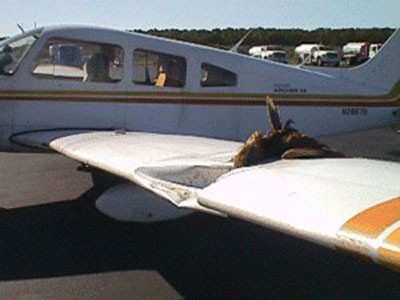Sat, Aug 25, 2012
Airports Are Required To Create And Implement Plans To Minimize Wildlife Hazards
In a report released Wednesday, the DOT's Inspector General found that FAA’s oversight and enforcement activities of its Wildlife Hazard Mitigation Program are not sufficient to ensure airports fully adhere to Program requirements or effectively implement their wildlife hazard plans. Under the Program, FAA requires airports to create and implement wildlife hazard management plans to assess and minimize the risk of future strikes.

"(The) FAA has not developed robust inspection practices, and its inspectors do not have the technical expertise to effectively oversee the Program," the report says. "Inspectors we spoke with mostly relied on interviews with airport personnel to determine compliance with regulatory requirements, rather than reviewing strike and airport records. Also, inspectors were not maintaining adequate records of their inspection activities."
The FAA’s policies and guidance for monitoring, reporting, and mitigating wildlife hazards are mostly voluntary, thereby limiting their effectiveness. For example, FAA recommends but does not mandate that airports and aircraft operators report all wildlife strikes to FAA’s strike database. As a result, FAA’s strike data are incomplete, which impacts the Agency’s ability to evaluate the effectiveness of its Program in reducing wildlife hazards. Finally, FAA coordinates effectively with the U.S. Department of Agriculture Wildlife Services, its main partner in wildlife hazard mitigation, but its efforts to coordinate with other relevant Government agencies are limited and infrequent.
The IG made 10 recommendations intended to improve FAA’s management and oversight of the Program. In its response, the FAA concurred with six, partially concurred with three, and did not concur with one. The IG said it is requesting additional information or revised responses for five recommendations—particularly related to improving the quality and quantity of the Agency’s wildlife strike data.

More News
From 2023 (YouTube Version): Legacy of a Titan Robert (Bob) Anderson Hoover was a fighter pilot, test pilot, flight instructor, and air show superstar. More so, Bob Hoover was an i>[...]
Get The Latest in Aviation News NOW on Instagram Are you on Instagram yet? It's been around for a few years, quietly picking up traction mostly thanks to everybody's new obsession >[...]
Aero Linx: B-52H Stratofortress The B-52H Stratofortress is a long-range, heavy bomber that can perform a variety of missions. The bomber is capable of flying at high subsonic spee>[...]
Altimeter Setting The barometric pressure reading used to adjust a pressure altimeter for variations in existing atmospheric pressure or to the standard altimeter setting (29.92).>[...]
"Knowing that we play an active part in bettering people's lives is extremely rewarding. My team and I are very thankful for the opportunity to be here and to help in any way we ca>[...]
 Classic Aero-TV: Remembering Bob Hoover
Classic Aero-TV: Remembering Bob Hoover ANN FAQ: Follow Us On Instagram!
ANN FAQ: Follow Us On Instagram! ANN's Daily Aero-Linx (05.15.24)
ANN's Daily Aero-Linx (05.15.24) ANN's Daily Aero-Term (05.15.24):Altimeter Setting
ANN's Daily Aero-Term (05.15.24):Altimeter Setting Aero-News: Quote of the Day (05.16.24)
Aero-News: Quote of the Day (05.16.24)




